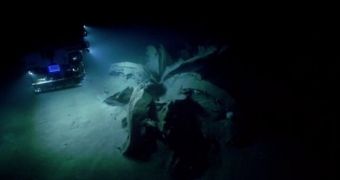A group of researchers exploring the bottom of the Gulf of Mexico have recently come across a rare structure that the scientific community refers to as a tar lily. The structure, pictured above, is the first of its kind to have until now been discovered in this part of the world.
Information shared with the public by the National Oceanic and Atmospheric Administration in the United States, otherwise known as NOAA, says that the researchers discovered this tar lily in the Gulf of Mexico quite by chance.
Thus, it appears that scientists first became aware of the existence of this structure while carrying out an acoustic survey. Based on information obtained in this manner, they assumed that what they were dealing with was a shipwreck, and they set out to explore it.
However, when they came face to face with the formation discovered by means of the acoustic survey, they found that it was not a shipwreck, but a rare flower-like extrusion of asphalt at the seafloor. The structure is said to have formed naturally as asphalt rose from the sub-seafloor.
“It looked like a shipwreck. And then once we get down there, we see this structure that we’ve never seen before. Never seen anything like it in the northern Gulf of Mexico,” marine biology student Thomas Heathman told the press in a recent interview, as cited by The Blaze.
Interestingly enough, it appears that, after they got over the shock of having made this discovery, the scientists continued exploring the area and ended up finding yet another tar lily that closely resembles the first one that they stumbled upon.
The researchers explain that these tar lilies in the Gulf of Mexico were found at a depth of about 1,900 meters (approximately 6,233 feet), and that they both accommodate for a surprisingly wide variety of aquatic wildlife, media reports says.
Thus, the first of the two tar lilies is said to serve as a home for fly trap anemones, unidentified sponges, goose neck barnacles, octocorals, sea pens, squat lobsters, and bamboo corals. The second one is colonized by hemosynthetic worms, a spiral coral, a few octocorals, and several branching bamboo corals.
Although they cannot say for sure when it was that these odd natural structures formed, specialists suspect that they have been around for hundreds, maybe even thousands of years.
According to the National Oceanic and Atmospheric Administration in the United States, the tar lilies were both discovered with the help of the a robotic vehicle connected to the Okeanos Explorer, a vessel owned by Administration.

 14 DAY TRIAL //
14 DAY TRIAL //